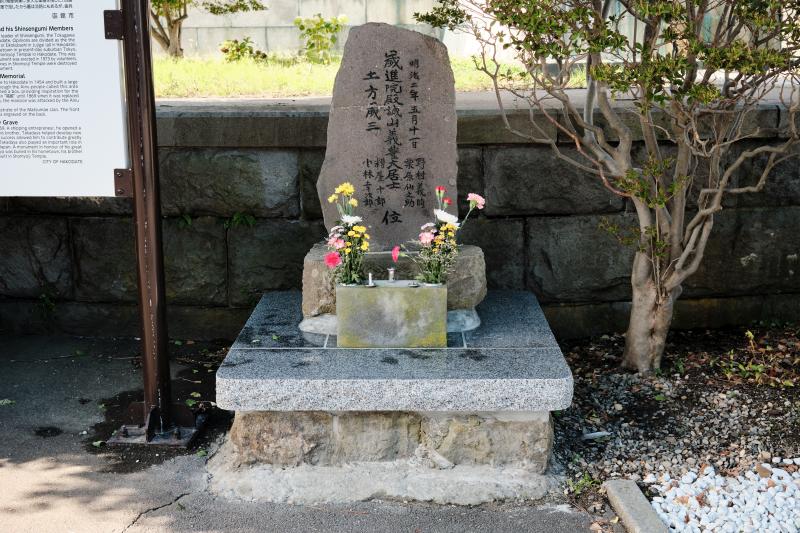
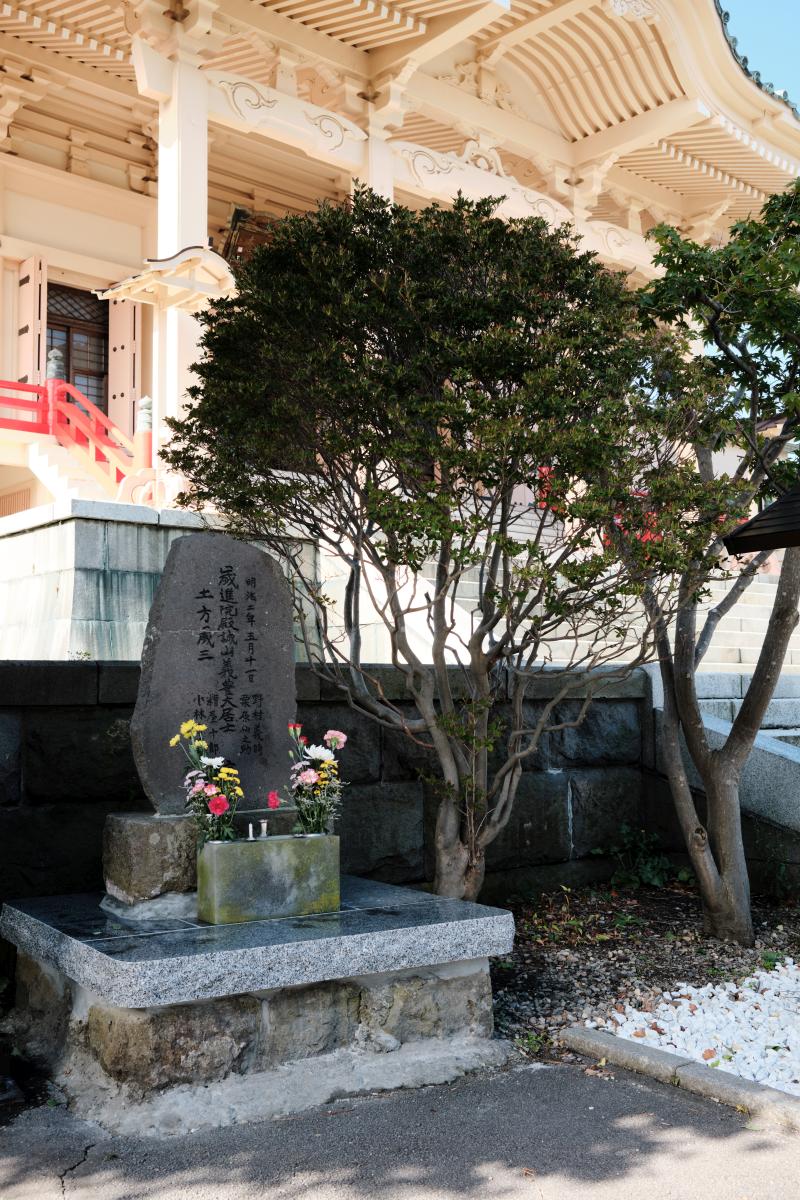
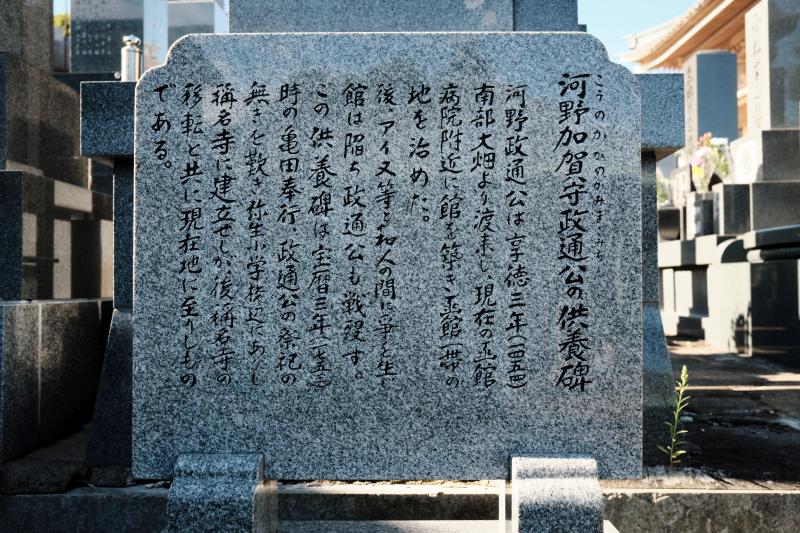
河野加賀守政通公の供養碑
河野政通公は享徳三年(一四五四)
南部大畑より渡来し、現在の函館
病院附近に館を築き函館一帯の
地を治めた。
後、アイヌ等と和人の間に争を生じ
館は陥ち政通公も戦歿す。
この供養碑は宝暦三年(一七五三)
時の亀田奉行、政通公の祭祀の
無きを歎き弥生小学校辺にありし
称名寺に建立せしが後称名寺の
移転と共に現在地に至りしもの
である。
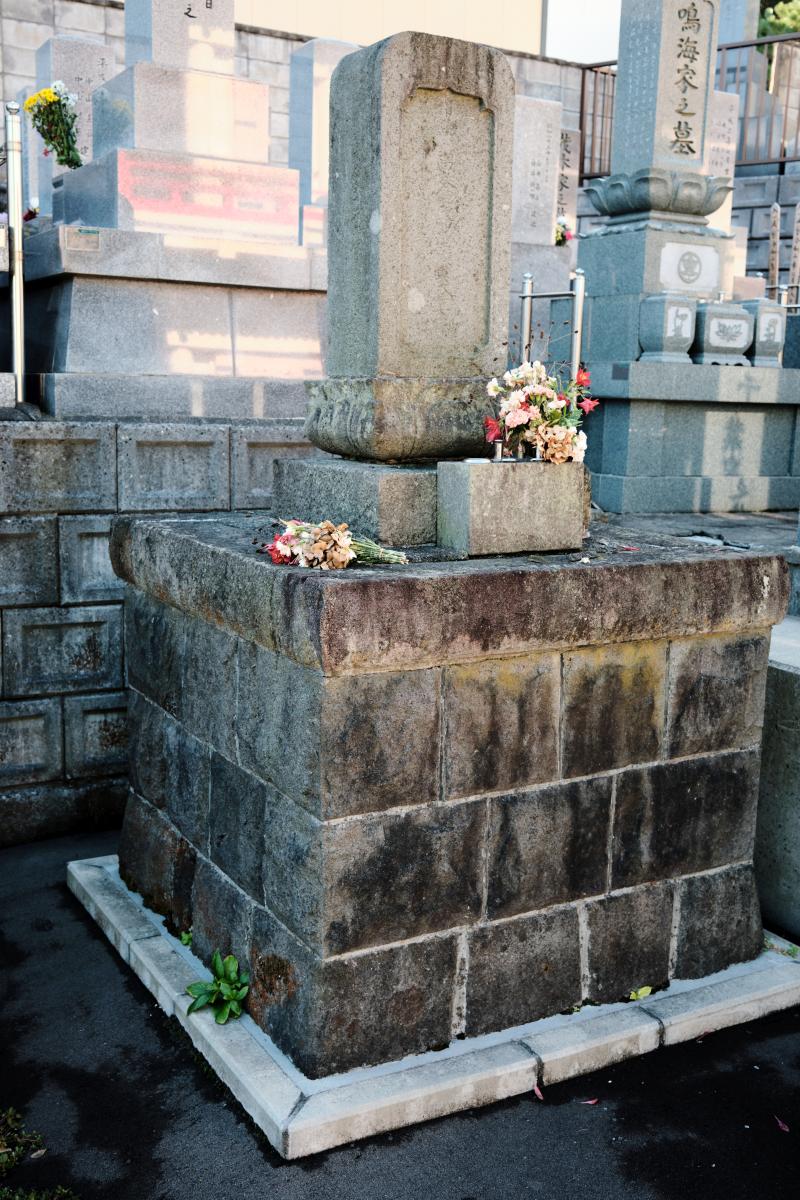
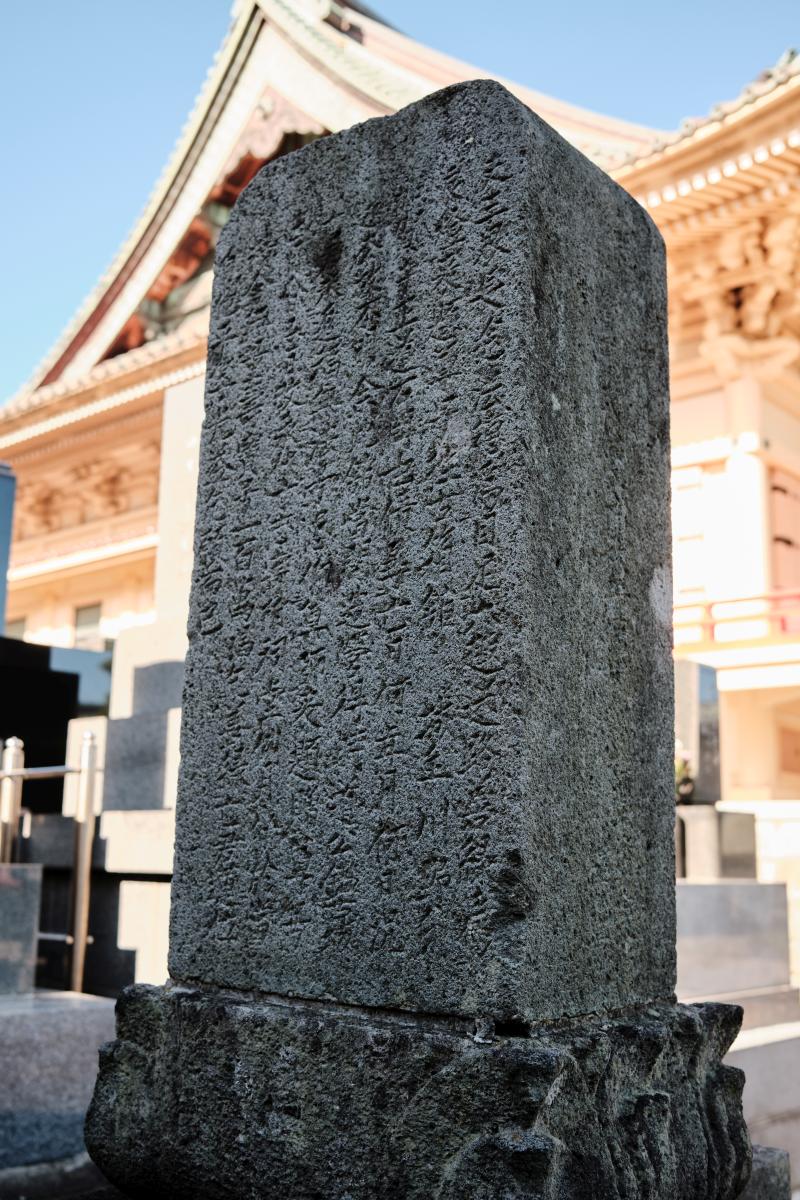
夫三界長途法徳為目足六趣迷道為良灯表題尊号往
国立国会図書館デジタルコレクション・松前景広『新羅之記録』,市立函館図書館,1937,7コマ目
古函館城主河野加賀守正道石碑也 倩尋亡日何月
何日况逝去不明余此館当国造営得時道公鑑古城亡
君来追福無法号患仰尊 表題贈尊号四月八日忌日
永代寸志寄附祠堂例月八日於当精舎無量寿法一百
万唱乞善縁亡君連信自他平等光益乞願而己
宝暦三稔癸酉林鏡仏日 願主酒井氏喜澄謹記焉
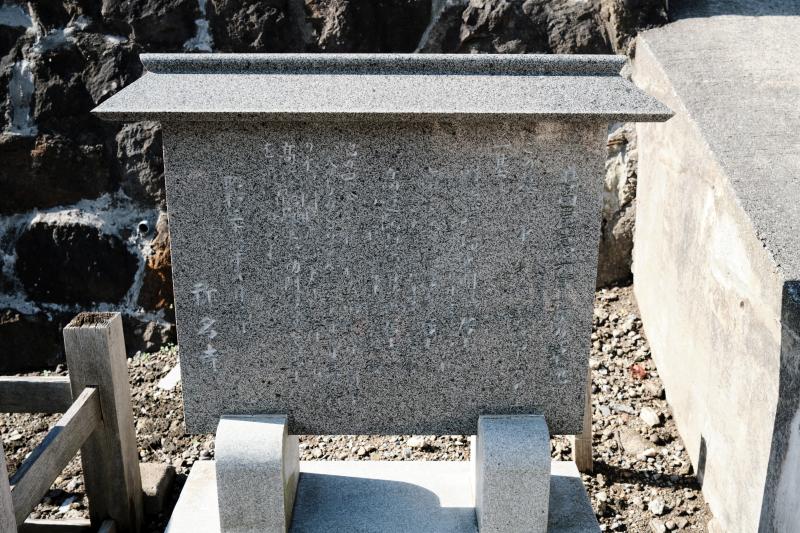
高田屋嘉兵衛一族の墓
この墓域の中にある正面中央の一基は
顕徳院瑞光明現居士
次兄 高田屋嘉蔵
高誉院至徳唐貫居士
長兄 高田屋嘉兵衛
高運院顕徳勇義居士
四弟 高田屋金兵衛
他の四基はそれぞれ函館に於ける同家一族のものである
大正六年二月十一日嘉兵衛の木造開眼式を挙行した折当山から高誉院殿至徳功阿唐貫大居士を追贈せられている
昭和三十一年八月三日
称名寺
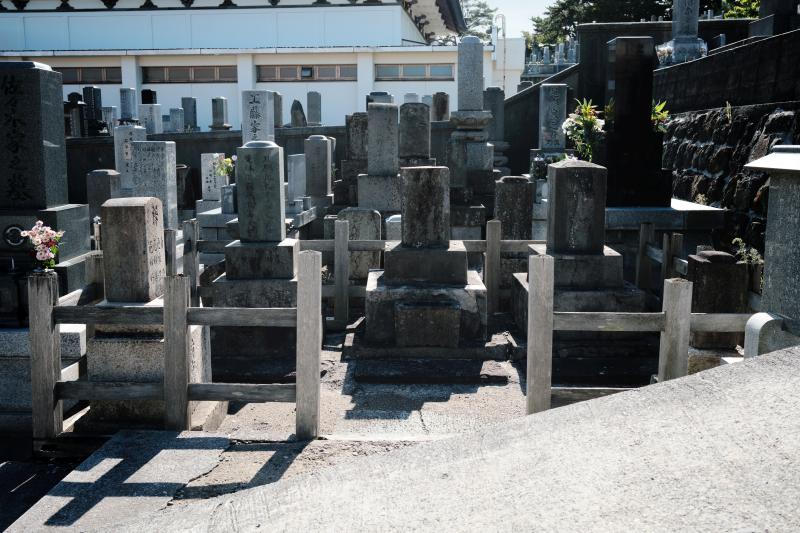
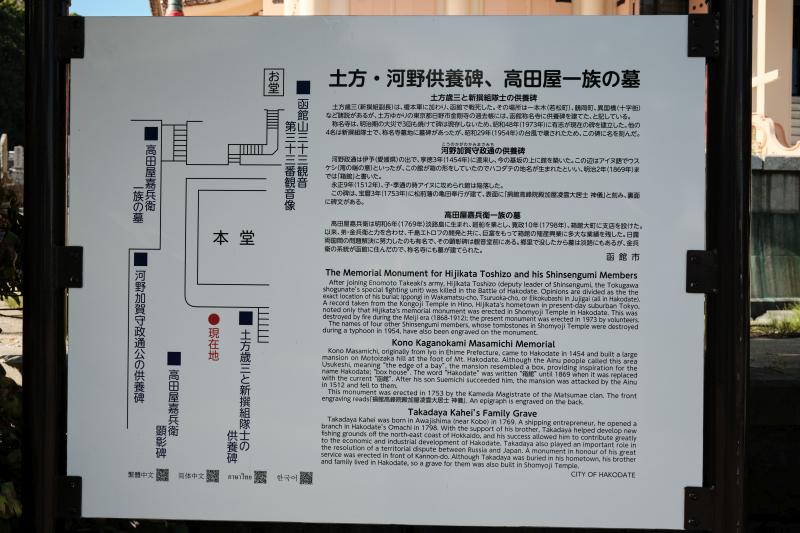
土方・河野供養碑、高田屋一族の墓
函館市
土方歳三と新撰組隊士の供養碑
土方歳三(新撰組副長)は、榎本軍に加わり、函館で戦死した。その場所は一本木(若松町)、鶴岡町、異国橋(十字街)など諸説があるが、土方ゆかりの東京都日野市金剛寺の過去帳には、函館称名寺に供養碑を建てた、と記している。
称名寺は、明治期の大災で3回も焼けて碑は現存しないため、昭和48年(1973年)に有志が現在の碑を建立した。他の4名は新撰組隊士で、称名寺墓地に墓碑があったが、昭和29年(1954年)の台風で壊されたため、この碑に名を刻んだ。
河野加賀守政通の供養碑
河野政通は伊予(愛媛県)の出で、享徳3年(1454年)に渡来し、今の基坂の上に館を築いた。この辺はアイヌ語でウスケシ(湾の端の意)といったが、この館が箱の形をしていたのでハコダテの地名が生まれたといい、明治2年(1869年)までは「箱館」と書いた。
永正9年(1512年)、子・季通の時アイヌに攻められ館は陥落した。
この碑は、宝暦3年(1753年)に松前藩の亀田奉行が建て、表面に「捐館高峰院殿加屋凌雲大居士 神儀」と刻み、裏面に碑文がある。
高田屋嘉兵衛一族の墓
高田屋嘉兵衛は明和6年(1769年)淡路島に生まれ、廻船を業とし、寛政10年(1798年)、箱館大町に支店を設けた。以来、弟・金兵衛と力を合わせ、千島エトロフの開発と共に、巨富をもって箱館の殖産興業に多大な業績を残した。日露両国間の問題解決に努力したのも有名で、その顕彰碑は観音堂前にある。郷里で没したから墓は淡路にもあるが、金兵衛の系統が函館に住んだので、称名寺にも墓が建てられた。
The Memorial Monument for Hijikata Toshizo and his Shinsengumi Members
CITY OF HAKODATE
After joining Enomoto Takeaki’s army, Hijikata Toshizo (deputy leader of Shinsengumi, the Tokugawa shogunate’s special fighting unit) was killed in the Battle of Hakodate. Opinions are divided as the the exact location of his burial; Ippongi in Wakamatsu-cho, Tsuruoka-cho, or Eikokubashi in Jujigai (all in Hakodate). A record taken from the Kongoji Temple in Hino, Hijikata’s hometown in present-day suburban Tokyo, noted only that Hijikata’s memorial monument was erected in Shomyoji Temple in Hakodate. This was destroyed by fire during the Meiji era (1868-1912); the present monument was erected in 1973 by volunteers.
The names of four other Shinsengumi members, whose tombstones in Shomyoji Temple were destroyed during a typhoon in 1954, have also been engraved on the monument.
Kono Kaganokami Masamichi Memorial
Kono Masamichi, originally from lyo in Ehime Prefecture, came to Hakodate in 1454 and built a large mansion on Motoizaka hill at the foot of Mt. Hakodate. Although the Ainu people called this area Usukeshi, meaning “the edge of a bay”, the mansion resembled a box, providing inspiration for the name Hakodate; “box house”. The word “Hakodate” was written “箱館” until 1869 when it was replaced with the current “函館”. After his son Suemichi succeeded him, the mansion was attacked by the Ainu in 1512 and fell to them.
This monument was erected in 1753 by the Kameda Magistrate of the Matsumae clan. The front engraving reads「損館高峰院殿加屋凌雲大居士 神儀」. An epigraph is engraved on the back.
Takadaya Kahei’s Family Grave
Takadaya Kahei was born in Awajishima (near Kobe) in 1769. A shipping entrepreneur, he opened a branch in Hakodate’s Omachi in 1798. With the support of his brother, Takadaya helped develop new fishing grounds off the north-east coast of Hokkaido, and his success allowed him to contribute greatly to the economic and industrial development of Hakodate. Takadaya also played an important role in the resolution of a territorial dispute between Russia and Japan. A monument in honour of his great service was erected in front of Kannon-do. Although Takadaya was buried in his hometown, his brother and family lived in Hakodate, so a grave for them was also built in Shomyoji Temple.



コメント